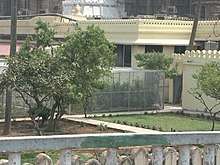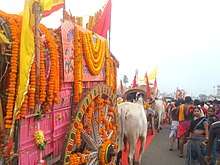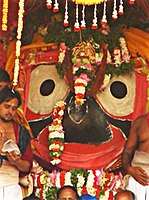Nabakalebara
Nabakalebara (Odia: ନବ କଳେବର) is a symbolic recreation of the wooden forms of three Hindu deities (Jagannath, Balabhadra, Subhadra, and Sudarshana) at Jagannath Temple, Puri. In the cult of Jagannath, the ritual is performed during the eighth, 12th, or 19th year after the previous Nabakalebara. Nabakalebara is an important festival in the Odia Hindu calendar, observed in the Jagannath Temple, Puri. It marks the demise and rebirth of lord Jagannath at Puri. The event involves installation of new images in the Jagannath temple and burial of the old ones in the temple premises at Koili Baikuntha.

Etymology
Nabakalebara is a combination of two Odia words: naba (new) and kalebara (body),[1] translated as "the change of one's physical form."
Timing
The year of Nabakalebara is when the full moon occurs twice during the month of Ashadha. Every three years in the Hindu calendar, a lunar month is excluded from the calculation to maintain a balance between lunar and solar years. This period is called Adhikmasa or Malamasa. A year with an extra month (अधिकमास or मलमास or पुरुषोत्तममास )is considered auspicious for the ceremony, which typically occurs every twelve to nineteen years. The three deities undergo the process of Nabakalebara in the year in which the adhikmasa falls.[2] The deities are carved from a special type of neem wood, known as daru bramha. Preparations for the ceremony begin in the month of Chaitra. The most recent ceremony was in 2015, 19 years after the 1996 ceremony.[3][4] Over three million devotees were expected to visit the temple during the Nabakalebara 2015.[5]
Jirna bera parityaga
Jirna bera parityaga (Odia: ଜୀର୍ଣ୍ଣବେର ପରିତ୍ୟାଗ) means "the leaving of the old deity and the consecration of the new". As a person puts on new garments and gives up the old, the soul accepts new material bodies and gives up old, useless ones. According to temple rituals, the deities are changed. Made from the neem tree, musk, sandalwood and other combinations, they undergo a change before the adhika ashadha ends. Agama shastras followed in other parts of India for Vishnu worship, such as the Vaikhanasas, also prescribe the change of wooden deities under a specific astrological combination. Deities made of stone or metal do not need to be changed (unless they are damaged), but wooden deities must be changed within a specific number of years and their power must be ritually transferred. Nabakalebar is about the transformation of the Puri temple and Odisha lords into a new body. The new wooden idols of Jagannath, Balabhadra, Subhadra and Sudarshan are welcomed to the temple in celebration. The old idols are ritually buried in Koili Baikuntha in accordance with century-old Odia scriptures.
Nabakalebara 2015
The Nabakalebara 2015 began with the Bana Jaga Jatra in March. The Holy Darus were identified and brought to Puri. For details, see the separate Wikipedia article.
Finding the sacred trees

Ordinary neem trees cannot be used to make the deities. For the identification of the tree, conditions and signs are taken into account.
The daru (log) of Sudarshan should have three branches. The skin (bark) of the neem tree should be reddish. The tree should have a chakra (wheel) with a small depression in the middle. The daru of Balabhadra should have seven branches. The bark of the tree should be light-brown or white. It should have the sign of a plow and pestle on it. Near the tree should be a heritage site and a graveyard. The daru of Subhadra should have five branches, and its bark should be yellowish. There should be a lotus flower on the tree. The daru of Jagannath should have four main branches, and its bark should be dark. The tree should have a Shankha and a chakra on it. There should be a cremation ground and an anthill near the tree, and a snake hole at its roots. The tree should be near a river, pond, a three-way crossing or three mountains. There should not be birds' nests on the tree, and no bird should have perched on the tree. The tree should be surrounded by other trees, and there should be a temple to Shiva in the vicinity. The tree should be free of parasitic plants and creepers.
| Deity | Bark colour | Branches | Sign | Nearby |
|---|---|---|---|---|
| Jagannath | Dark | 4 | Shankha an chakra | Cremation ground, anthill near the tree and snake hole at the roots of the tree, river/pond/three-way crossing/three mountains, no nests or perches, surrounded by other trees, Shiva temple, free of parasitic plants and creepers |
| Balabhadra | Light brown/white | 7 | Plow and pestle | Heritage site and graveyard |
| Subhadra | Yellowish | 5 | Lotus flower | |
| Sudarshan | reddish | 3 | Chakra with small depression in centre |
| Year | Jagannath | Balabhadra | Subhadra | Sudarshan |
|---|---|---|---|---|
| 16 July 1912 | Prataprudrapur | Niali | Polar Mahal | Fetehgarha |
| 17 July 1931 | Gabapada | Satwikpur | Niali | Kakatpur |
| 16 July 1950 | Khadihara | Nuapatna | Durgeswar | Jalarpur |
| 16 July 1969 | Champajhar | Bhakar Street | Kanhupur | Balara |
| 18 July 1977 | Raichakradharpur | Bhogeswar | Baraboi | Niali |
| 17 July 1996 | Dadhimachhagadia | Ramakrushnapur | Malada | Bisoidiha |
| 18 July 2015 | Kharipadia | Kanakpur | Adanga | Gadakuntania |
Rituals
The search group announces where the logs are located in order; the last is Jagannath's tree. Security is arranged by the government of Odisha. The trees are ritually cut down, and the logs transported in small carts to the temple in Puri, where they are carved into deities. At midnight on Chaturdashi, the tattva Padārtha is transferred from the old deities to the new. The new deities are worshipped, and the old are buried in sand.
Rituals and mythology are attached to Nabakalebara. The procedure for the transformation of images was mentioned in Sanskrit manuscripts, written on palm leaves and kept in the temple. The temple's three head priests are charged with reading and interpreting them.
The images of Jagannath must be made of wood. Since the deity is dark, the neem tree from which his image is carved should be dark also. The trees used for the images of his brother and sister are lighter in color, since his siblings are fair in complexion.
Jagannath's tree must have four principal branches, symbolizing the four arms of Narayana. No branches are broken or cut. The tree must be located near a three-way intersection or surrounded by three mountains. A hermitage and a temple to Shiva must be nearby, and natural impressions of a conch-shell and chakra (wheel) must be on the trunk.
After the tree is felled, sections are selected for carving and the remainder is buried; the location is then considered sacred. The logs are placed in a wooden six-wheeled oxcart and transported to the temple, where they are kept in the koili vaikuntha (koili means "burial ground", and vaikuntha means "heaven"); the old deities are buried, and the new ones made. After the transfer of essence, the old images are considered lifeless.
Carving of the images begins with the three oldest of the nine main wood carvers working on Jagannath. The images of Lord Balabhadra and Devi are simultaneously carved by two three-person teams. More than 50 carpenters assist the carvers. The work is done in secret, and not even the temple's head priest is allowed to visit the workplace. The carving enclosure is open on the top, but closed with strong doors. The carvers are not supposed to eat, drink or smoke in the enclosure. The carvings are completed in 21 days, during which the carvers are not supposed to leave the temple; they sleep in the temple courtyard, and eat mahaprasad. Devotional songs are sung by devadasis, accompanied by temple musicians, outside the koili vaikuntha during the carving period; shlokas from the Vedas are chanted by Brahmin priests.
After the new deities are made they are brought into the temple's inner sanctum, they are placed in front of (and facing) the old ones. No puja is performed at this time, and no food is offered. The images are life-sized, and very heavy. The transformation ceremony takes place three days before the chariot festival.
At midnight, the old deities are carried out and buried in the koili vaikuntha before dawn. Although the other deities have separate graves, the previous Jagannaths are buried on top of each other.
On the morning of the second day, the new deities are seated on the altar. The temple's daily routine resumes after nearly 58 days (the search and carving periods). Sweet-smelling flower garlands and new garments are given to the new deities, food is offered, and a puja is performed; devotees can again enter the temple. On the third day, the new deities emerge from the temple for the chariot festival. Nabakalebara attracts millions of people from around the world to Puri, and is one of India'a largest festivals.[6][7]
References
- "President releases commemorative coins on Nabakalebar festival | Current Affairs Today". currentaffairs.gktoday.in. Retrieved 2018-03-30.
- Details of Nabakalevara Ceremony
- "Millennium's first Nabakalebar Rath Yatra held at Puri - The Hindu". 2015.
- "BDA to prepare roadmap for Nabakalebar festival - Times Of India". articles.timesofindia.indiatimes.com. 2012. Retrieved 4 January 2013.
more than 10 lakh visitors thronged Puri during 1996 Nabakalebar festival
- "Plans afoot to manage Nabakalebar crowd". Times of India. 12 July 2014. Retrieved 13 July 2014.
- "The Hindu : NATIONAL / OTHER STATES : State gearing up for Nabakalebar festival". thehindu.com. 2012. Retrieved 4 January 2013.
Expecting large religious congregation as big as that of Kumbh Mela during Nabakalebar festival of Lord Jagannath in 2015
- "Odisha CM urges Centre to commission Khurda Road-Puri Section (Doubling) before Nabakalebar Festival, Orissa Current News". orissadiary.com. 2012. Retrieved 4 January 2013.
In the last Nabakalebar, 1996, around 20 lakh pilgrims attended the festival.
